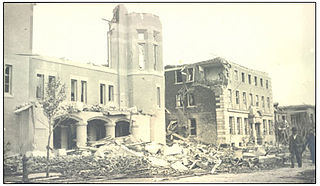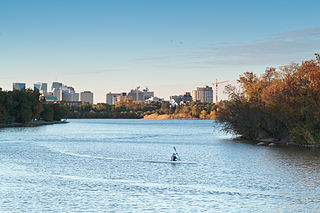
Regina is the capital city of the Canadian province of Saskatchewan. The city is the second-largest in the province, and is a commercial centre for southern Saskatchewan. As of the 2021 census, Regina had a city population of 226,404, and a metropolitan area population of 249,217. It is governed by Regina City Council. The city is surrounded by the Rural Municipality of Sherwood No. 159.

Saskatoon is the largest city in the Canadian province of Saskatchewan. It straddles a bend in the South Saskatchewan River in the central region of the province. It is located along the Trans-Canada Yellowhead Highway, and has served as the cultural and economic hub of central Saskatchewan since its founding in 1882 as a Temperance colony.

The University of Regina is a public university located in Regina, Saskatchewan, Canada. Founded in 1911 as a private denominational high school of the Methodist Church of Canada, it began an association with the University of Saskatchewan as a junior college in 1925, and was disaffiliated by the Church and fully ceded to the university in 1934; in 1961 it attained degree-granting status as the Regina Campus of the University of Saskatchewan. It became an autonomous university in 1974. The University of Regina has an enrolment of over 15,000 full and part-time students. The university's student newspaper, The Carillon, is a member of CUP.

The Regina Cyclone, or Regina tornado of 1912, was a tornado that devastated the city of Regina, Saskatchewan, Canada, on Sunday, June 30, 1912. It remains the deadliest tornado in Canadian history with a total of 28 fatalities and about 300 people injured. At about 4:50 p.m., green funnel clouds formed and touched down south of the city, tearing through the residential area between Wascana Lake and Victoria Avenue, and continuing through the downtown business district, rail yards, warehouse district, and northern residential area.

SaskTel Centre is an arena located in Saskatoon, Saskatchewan, Canada. The facility opened in February 1988 and is currently the home venue of the Saskatoon Blades of the Western Hockey League, the Saskatchewan Rattlers of the Canadian Elite Basketball League, and the Saskatchewan Rush of the National Lacrosse League, with the arena being referred to as Co-op Field at SaskTel Centre during Rush games.

The history of Regina, Saskatchewan, the capital of the Canadian province of Saskatchewan. Prior to the province's establishment, Regina served as the territorial headquarters of the then-North-West Territories and district headquarters of the territorial district of Assiniboia.

Government House in Regina, Saskatchewan, Canada, is the official office of the lieutenant governor of Saskatchewan. It was first constructed as a residence for the lieutenant governor of the North-West Territories, whose territorial headquarters were in Regina. When the provinces of Saskatchewan and Alberta were created out of the Territories in 1905, Regina became the capital of Saskatchewan and Government House became the official residence of the lieutenant governor of Saskatchewan. It was vacated in 1944 and then returned to official ceremonial use in 1984.
Regina, Saskatchewan has a rich cultural life in music, theatre and dance, amply supported by the substantial fine arts constituency at the University of Regina, which has a large fine arts department including faculties of music and theatre. At various times this has attracted notable artistic talent: Donald M. Kendrick and Joe Fafard have been particular stars.

Wascana Centre is a 930-hectare urban park built around Wascana Lake in Regina, Saskatchewan, Canada, established in 1912 with a design from renowned architect Thomas Mawson. The park is designed around the Saskatchewan Legislative Building and Wascana Lake. High-profile features include the University of Regina, Royal Saskatchewan Museum, Conexus Arts Centre, Saskatchewan Science Centre, and CBC Regional Broadcast Centre. Wascana Centre brings together lands and buildings owned by the City of Regina, University of Regina, and Province of Saskatchewan. The park is located immediately south of the city's downtown core, bordered by residential areas on the east, south and west, and on the south-east edge it spills out onto open Saskatchewan prairie along Wascana Creek.

Many historically significant buildings in Regina, Saskatchewan were lost during the period 1945 through approximately 1970 when the urge to "modernize" overtook developers' and city planners' sense of history and heritage. The old warehouse district to the north of the old CPR tracks was Regina's original commercial raison d'être once Lieutenant-Governor Edgar Dewdney had established the site of his considerable landholdings as the Territorial Capital. 1899 to 1919 Washington Park and 3431 Dewdney Ave building as CPR commercial logistics building, expanded connected with significant conversion of shipping of commercial goods from train to truck and cancellation of passenger service on the railway, the Warehouse District immediately adjacent to the train line has ceased to be exclusively industrial in character. Some areas of the Warehouse District have been transformed into a shopping, entertainment and residential precinct.
Regina, Saskatchewan, Canada is a travel destination for residents of southern Saskatchewan and the immediately neighbouring regions of the U.S. states of North Dakota and Montana. It is also a convenient rest-stop for travellers along the Trans-Canada Highway. Attractions for visitors include the following:

By the arrangements of the Canadian federation, the Canadian monarchy operates in Saskatchewan as the core of the province's Westminster-style parliamentary democracy. As such, the Crown within Saskatchewan's jurisdiction is referred to as the Crown in right of Saskatchewan, His Majesty in right of Saskatchewan, or His Majesty the King in right of Saskatchewan. The Constitution Act, 1867, however, leaves many royal duties in Saskatchewan specifically assigned to the sovereign's viceroy, the Lieutenant Governor of Saskatchewan, whose direct participation in governance is limited by the conventional stipulations of constitutional monarchy.

The Central Business District is one of seven development districts in Saskatoon, Saskatchewan, Canada. The central business district is Ward 6 of a Mayor-Council government represented by councillor Cynthia Block. Formerly called West Saskatoon, this area arose when the steam engines built their pumping stations on the lower west bank of the South Saskatchewan River. Retail enterprises sprang up around the newly created train station and rail yards. The city of Saskatoon's Central Business District has shopping malls and boutiques.

Central Industrial is a light industrial area in Saskatoon, Saskatchewan, Canada, that comprises educational, recreational facilities, hotels and businesses along Idylwyld Drive. The community meets up with the Central Business District CBD to the west and south, and residential areas east and north.

Seven neighbourhoods are of considerable note:
Broadway Across Canada is a Toronto, Ontario-based theatrical presenter which presents touring Broadway shows, family productions and other live theatrical events across Canada.
TCU Place, formerly known as the Saskatoon Centennial Auditorium, is a 104,000-square-foot (9,700 m2) convention and arts centre in Saskatoon, Saskatchewan, Canada. Situated in the Central Business District it is located next to Midtown Plaza.

Knox-Metropolitan United Church stands on Lorne Street at Victoria Avenue across from Victoria Park in downtown Regina, Saskatchewan, Canada. It is the current manifestation of Presbyterian and Methodist congregations that date back to "worship services in both traditions…in 1882."
Jack Sures was a Canadian ceramic artist and post-secondary academic.

Jacqueline Fanchette Clotilde Clay Shumiatcher, was a Canadian philanthropist, arts patron, and art collector. She and her husband Morris C. Shumiatcher began supporting the arts community in Regina, Saskatchewan, shortly after their marriage in 1955, an endeavor which she continued since Morris' death in 2004. The couple were avid collectors of Inuit art and artwork by local artists. In 2014 she donated 1,310 Inuit sculptures and paintings by the Regina Five, worth an estimated C$3 million, to the University of Regina. She received many honours and awards, including the Saskatchewan Order of Merit in 2001 and the Order of Canada in 2017.


















